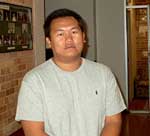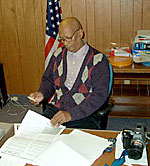The New Disparities
By Brandt Williams
Minnesota Public Radio
November 2001
|
| RealAudio |
Discussions of race and the criminal justice system tend to focus on the disproportionate rates at which African-Americans are arrested and jailed. However, the growth of Latinos, Hmong and Somali in Minnesota has broadened the scope of the disparities issue.
Skin color, ethnicity, language and culture often complicate interactions between law enforcement and members of immigrant and refugee communities. The police and courts are trying to adjust to the increasing diversity. But some say the changes aren't coming fast enough.
| |
|
|
|
||
Over the past 10 years, the Hmong, Somali and Latino populations have sharply increased in Minnesota. Minnesota's Latino population alone has tripled, and that has resulted in increased tension between police and new immigrants.
Long Prairie is like many small towns in greater Minnesota. It has experienced a rapid growth of Mexican immigrants. The town has a population of 3,000. Some estimate that Mexican immigrants make up one-third of the population Many immigrants have moved to Long Prairie to work in a nearby food processing plant and work in other agriculture-based businesses.
Jesus Peres has come into the Todd County Hispanic Liaison Office to get a medical bill translated. He says police officers stop Mexicans just to check their immigration status. "They stop us because we're Mexican," he says through an interpreter. "And the Americans - they don't stop them. They're just driving all over the place and they don't seem to stop them."
A legal rights center for Latinos recently examined the reports of 17 traffic stops conducted by Long Prairie police officers. St. Paul-based Centro Legal found that during each of those stops, police officers called the Border Patrol to translate conversations between the officer and the offender. Thirteen of the 17 traffic stops resulted in deportations.
"Are we acting as agents of the Border Patrol? Absolutely not," says Long Prairie Police Chief Steve Neet, who says his officers use the Border Patrol to identify people who are not carrying identification. He says sometimes they call on the Border Patrol because some of its agents speak Spanish.
The Long Prairie police force has six full-time and four part-time officers. None of them speaks Spanish. Neet says his officers don't target Hispanics, but he says sometimes cultural differences lead to misunderstandings. "If your name is Juan Rodriguez Mendoza, that may be your correct name, but on the other hand, how it's interpreted and how it's translated to a piece of paper may be different from what it's supposed to be. It might say Juan Mendoza Rodriguez," says Neet.
| |
|
|
|
||
The Latino population in Long Prairie has exploded only within the past five years. However Hmong immigrants have been in Minnesota for many years. Hmong people make up the majority of the state's Asian-American population. Most of them live in St. Paul. The presence of Asian gangs in the city has led to closer contact between the police and the Hmong community. As a result, the St. Paul Police Department has recruited about 20 Asian-American officers. And all St. Paul police officers are required to take an hour-and-a-half awareness course on Hmong culture.
Social worker Long Vang, who works with Hmong boys at the Hmong American partnership in St. Paul, says many of the boys he works with are gang members. He says nearly all of them have been arrested at some time. He says he's noticed improvements in how police and other law enforcement officials interact with Hmong people.
"They have been really looking at bringing competent workers to really deal with culture issues or resources to help with the native language of individuals and I think they've been really helpful the past two to three years, but prior to that everyone was on their own."
Vang says one way the system has changed to accommodate Hmong offenders is by hiring Hmong probation officers. There are several Hmong probation officers in Ramsey County, and Vang says their presence has made a difference with young offenders.
Both Minneapolis and St. Paul police departments have compiled data on the race of persons stopped by police officers. In both cities, blacks and Latinos are pulled over at rates disproportionately higher than their populations. Asian-Americans were pulled over in numbers nearly equal to their presence in the two cities. There's no breakdown into Hmong or Somali figures in each city. However, some Somalis say they've been mistreated by police officers.
Saphia Omar, a social worker with the Somali Community of Minnesota, says many Somalis tell her that the police enter and search their homes without a warrant. She says many Somalis have bad memories from refugee camps of being mistreated by police and soldiers. "And the police was always the enemy in their sight. And now in this part of the world where they should feel police comfortable and feel the police they will protect them. But actually that don't take place. That's not what happens," she says.
| |
|
|
|
||
Dr. Hassan Eibakar, a Somali elder and publisher of a Somali newspaper and magazine, says community members come to him with their complaints about police conduct. He says he investigates the claims and finds that many of them are based on misunderstandings on the part of Somalis. He sits in his office located near a busy intersection a few blocks from downtown Minneapolis. He agrees that Somalis may have brought residual fear of the police with them from their homeland, but he says that when Somalis learn that police in America are different from the police back home, they will not be afraid anymore.
"They actually treat people equally and I know, being a journalist. The only thing is that there is this kind of complex of fear to anyone who is dressed like military, like police. So we have to see the situation into those lines to understand why certain attitudes occur in the Somali community," according to Eibakar.
One of the biggest challenges facing Somalis, Hmong and Latinos is the language barrier. Judge Tanya Bransford serves on the Minnesota Supreme Court's Multicultural, Diversity and Racial Fairness in the Courts Committee. The committee oversees the implementation of recommendations made by the state Supreme Court's Racial Bias Task Force. She says the demand for interpreters has put a financial strain on the system, but she says its worth it.
Bransford says Minnesota courts have made some progress, especially in the area of interpreters. "However there's still the disparate number of people of color in prison. So we haven't made any progress there. The statistics say we're one of the worst states in the nation with regards to the disparity the number compared to the number of people of color in the community compared to those who are actually in prison," according to Bransford.
Since January, the courts have been recording racial data on all criminal, juvenile and traffic cases which require an appearance before a judge. Bransford says she hopes the data collection will help the courts find the source of the disparities. Meanwhile, she says, the committee will continue to press for more changes, such as the hiring of more bilingual personnel.



